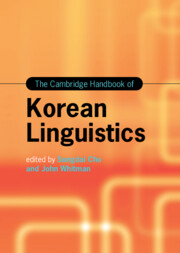Book contents
- The Cambridge Handbook of Korean Linguistics
- Cambridge Handbooks in Language and Linguistics
- The Cambridge Handbook of Korean Linguistics
- Copyright page
- Contents
- Figures
- Tables
- Contributors
- Preface
- Acknowledgments
- Abbreviations
- Part I Korean Overview
- Chapter 1 Introduction
- Chapter 2 Phonology: An Overview
- Chapter 3 Overview of Chapters on Syntax
- Chapter 4 On the Centrality of Korean in Language Contacts in Northeast Asia
- Chapter 5 Politeness Strategies in Korean
- Chapter 6 Korean Kugyŏl
- Part II Phonetics and Phonology
- Part III Morphology and Syntax
- Part IV Semantics and Pragmatics
- Part V Sociolinguistics and Psycholinguistics
- Part VI Language Pedagogy
- Index
- References
Chapter 1 - Introduction
from Part I - Korean Overview
Published online by Cambridge University Press: 30 September 2022
- The Cambridge Handbook of Korean Linguistics
- Cambridge Handbooks in Language and Linguistics
- The Cambridge Handbook of Korean Linguistics
- Copyright page
- Contents
- Figures
- Tables
- Contributors
- Preface
- Acknowledgments
- Abbreviations
- Part I Korean Overview
- Chapter 1 Introduction
- Chapter 2 Phonology: An Overview
- Chapter 3 Overview of Chapters on Syntax
- Chapter 4 On the Centrality of Korean in Language Contacts in Northeast Asia
- Chapter 5 Politeness Strategies in Korean
- Chapter 6 Korean Kugyŏl
- Part II Phonetics and Phonology
- Part III Morphology and Syntax
- Part IV Semantics and Pragmatics
- Part V Sociolinguistics and Psycholinguistics
- Part VI Language Pedagogy
- Index
- References
Summary
Korean has emerged as an important world language both for an expanding constituency of learners and teachers of Korean as a foreign/second language, as well as for scholars and students of general and Korean linguistics. Thousands of heritage schools, elementary, intermediate and high schools, colleges and universities, private institutes and government agencies around the world offer Korean language instruction at a range of levels. The number of institutions offering Korean and, consequently, the number of students learning Korean is constantly on the increase in Australia, Europe, China, Japan, New Zealand, the former Soviet Union, and the United States. An ever-growing number of general and Korean linguists, linguistics students, and language educators are interested in the structure and use of Korean and its universal and typological features from diachronic, synchronic, and dynamic perspectives.
- Type
- Chapter
- Information
- The Cambridge Handbook of Korean Linguistics , pp. 3 - 16Publisher: Cambridge University PressPrint publication year: 2022



